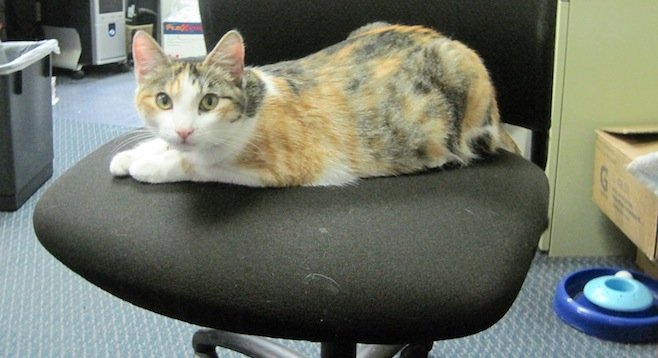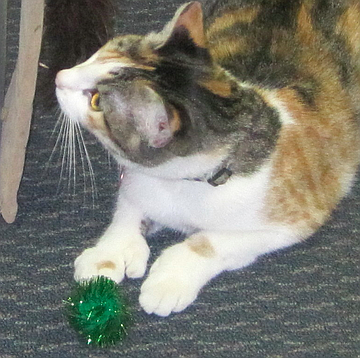 Facebook
Facebook
 X
X
 Instagram
Instagram
 TikTok
TikTok
 Youtube
Youtube

The sun, in the form of Enyaa the six-toed cat, comes out at night at Mission Trails Regional Park Visitor Center. Enyaa ("en" as in "hen;" "yaa" rhymes with "caw") is the Kumeyaay word for the sun. The feline is the center's chief rodent control officer, according to her staff photo in the lobby. (The park foundation pays for her expenses.)
During the day, Enyaa lives in the staff area. Once the center is closed, she patrols the building. The taxidermied animals attract mice, ranger Heidi Gutknecht said in a November 3 interview. In addition, rodents seek shelter during the winter.
Enyaa, who's been on the job since July, is the center's third mouser. Fortuna, an orange tabby named for a park mountain, served from 1999–2001. Kwaay Paay ("chief" or "captain"), a tortoiseshell named for another park mountain, was the mouser from 2001 until last May.
Gutknecht and Roland Roberge, foundation administrative assistant, found the current mouser at the county animal shelter in Linda Vista. The feline, estimated by the veterinarian to be one and a half years old, is a "torby," a cat with tabby stripes and the tortoiseshell's varied coloring.

Gutknecht is pleased that the torby honors Enyaa's predecessors. She pointed out the resemblance of Enyaa's paw to a baseball glove, saying the extra toe was an advantage for a mouser. "She leaves the whole mouse carcass; Kwaay Paay would eat the top and leave the bottom for us." (Enyaa's kills are left outdoors for wildlife to eat.)
The cat was originally called Ms. Cowles, a tribute to the mountain and Jennie Cowles, who settled in the area with her husband George in 1877. Someone said "Ms." wasn't used in the 19th Century. Another issue was pronouncing "Cowles": park personnel say it's pronounced "coals," not the "o" sound in "cow."
The cat's coworkers decided on a Kumeyaay name, and Gutknecht looked up several phrases. The humans rejected the Kumeyaay translation of "six toes" and "one who talks a lot." Since foundation executive director Jay Wilson called the cat "sunshine," Gutknecht found the word "Enyaa."
It took Enyaa about a month to adapt to her home where movement on the ramp to the second floor activates the sounds of a coyote, mountain lion, and owl. "I tried to show her around, and it took Enyaa a while to go up the ramp," said Gutknecht.
Now the sound of the office printer sends the cat racing to watch pages emerge. She's also a clockwatcher. After glancing at the large clock on the wall above Gutknecht's desk, Enyaa climbs onto a cabinet, "stands up and reaches her paw to try to catch the second hand," said Gutknecht. "She scales the cubicle walls like Spider Man."
One night, Enyaa redecorated. She emptied garbage bags filled with plastic bags brought in by volunteers. The smaller bags are placed in the park so people will clean up after their dogs. Enyaa scattered those bags in various rooms, Gutknecht said.
"She makes us laugh a lot."


The sun, in the form of Enyaa the six-toed cat, comes out at night at Mission Trails Regional Park Visitor Center. Enyaa ("en" as in "hen;" "yaa" rhymes with "caw") is the Kumeyaay word for the sun. The feline is the center's chief rodent control officer, according to her staff photo in the lobby. (The park foundation pays for her expenses.)
During the day, Enyaa lives in the staff area. Once the center is closed, she patrols the building. The taxidermied animals attract mice, ranger Heidi Gutknecht said in a November 3 interview. In addition, rodents seek shelter during the winter.
Enyaa, who's been on the job since July, is the center's third mouser. Fortuna, an orange tabby named for a park mountain, served from 1999–2001. Kwaay Paay ("chief" or "captain"), a tortoiseshell named for another park mountain, was the mouser from 2001 until last May.
Gutknecht and Roland Roberge, foundation administrative assistant, found the current mouser at the county animal shelter in Linda Vista. The feline, estimated by the veterinarian to be one and a half years old, is a "torby," a cat with tabby stripes and the tortoiseshell's varied coloring.

Gutknecht is pleased that the torby honors Enyaa's predecessors. She pointed out the resemblance of Enyaa's paw to a baseball glove, saying the extra toe was an advantage for a mouser. "She leaves the whole mouse carcass; Kwaay Paay would eat the top and leave the bottom for us." (Enyaa's kills are left outdoors for wildlife to eat.)
The cat was originally called Ms. Cowles, a tribute to the mountain and Jennie Cowles, who settled in the area with her husband George in 1877. Someone said "Ms." wasn't used in the 19th Century. Another issue was pronouncing "Cowles": park personnel say it's pronounced "coals," not the "o" sound in "cow."
The cat's coworkers decided on a Kumeyaay name, and Gutknecht looked up several phrases. The humans rejected the Kumeyaay translation of "six toes" and "one who talks a lot." Since foundation executive director Jay Wilson called the cat "sunshine," Gutknecht found the word "Enyaa."
It took Enyaa about a month to adapt to her home where movement on the ramp to the second floor activates the sounds of a coyote, mountain lion, and owl. "I tried to show her around, and it took Enyaa a while to go up the ramp," said Gutknecht.
Now the sound of the office printer sends the cat racing to watch pages emerge. She's also a clockwatcher. After glancing at the large clock on the wall above Gutknecht's desk, Enyaa climbs onto a cabinet, "stands up and reaches her paw to try to catch the second hand," said Gutknecht. "She scales the cubicle walls like Spider Man."
One night, Enyaa redecorated. She emptied garbage bags filled with plastic bags brought in by volunteers. The smaller bags are placed in the park so people will clean up after their dogs. Enyaa scattered those bags in various rooms, Gutknecht said.
"She makes us laugh a lot."
Comments